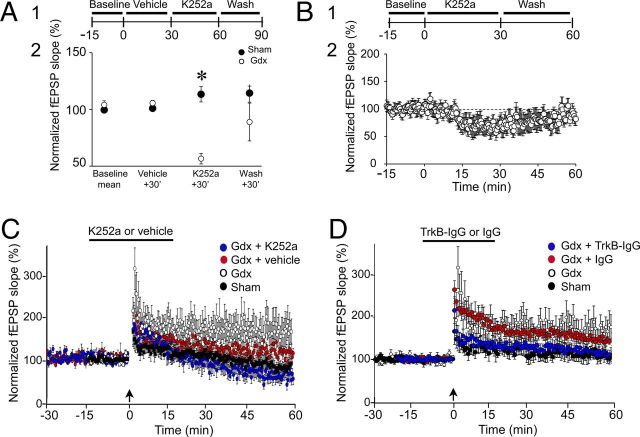Figure 10.
K252a reduces MF transmission and LTP in Gdx rats but not sham controls. A1, The experimental procedure is diagrammed. Slices from Gdx rats (○; n = 4 slices, 4 rats) or sham rats (●, n = 4 slices, 4 rats) were exposed to vehicle (0.003% DMSO) for 30 min and then 300 nm K252a followed by drug-free ACSF. A2, MF fEPSP slopes in Gdx rats decreased when exposed to K252a: *p < 0.05 (one-way RM-ANOVA followed by post hoc tests), but there was no effect in sham rats (one-way RM-ANOVA; p > 0.05). B1, The experimental procedure is shown. Slices from Gdx rats (8 slices, 8 rats) were perfused with 300 nm K252a for 30 min and then returned to drug-free buffer. B2, Normalized MF fEPSP slope is plotted for all slices. K252a reduced fEPSP slope, and there was recovery with wash. C, Slices from Gdx rats were tested for 15 min to establish a stable baseline and then pretreated with 300 nm K252a for 15 min (blue circles; 7 slices, 5 rats) or vehicle (red circles; 9 slices, 6 rats), and then the trains to induce LTP were triggered (arrow). After 15 min, perfusion with drug-free ACSF resumed. There was greater LTP in slices from Gdx rats treated with vehicle compared with Gdx rats treated with K252a (measured 60 min after LTP induction, Student's t test, p < 0.05). For comparison, the results of experiments that used untreated slices from Gdx rats (○) and untreated slices from sham rats (●) are shown (from Fig. 3). D, After a 15-min-long baseline, slices from additional Gdx rats were exposed to 1 ng/ml TrkB-IgG for 10 min (blue circles; 7 slices, 6 rats) or control IgG (1 ng/ml; red circles; 9 slices, 6 rats). After LTP induction, TrkB-IgG or IgG was continued for 10 min. Then drug-free buffer was reinstated. Data from slices that were from untreated Gdx rats (○) and untreated slices from sham rats (●) are also shown, as for C. Slices from Gdx rats that were treated with TrkB-IgG were not statistically different from untreated slices from sham rats at 60 min after LTP induction (p < 0.05; Student's t test). Slices from Gdx rats that were treated with vehicle were not different from untreated Gdx rats (p < 0.05; Student's t test). The results suggest that a Trk-sensitive form of LTP emerged after Gdx.

